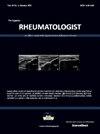Fractional excretion ratio of activated leukocyte cell adhesion molecule (ALCAM) as a potential biomarker in lupus nephritis patients
IF 1
Q4 RHEUMATOLOGY
引用次数: 0
Abstract
Aim of the work
To investigate the use of fractional excretion ratio (FE) of activated leukocyte cell adhesion molecule (ALCAM) in patients with lupus nephritis (LN) and whether, in comparison to the absolute urine levels, they demonstrate improved diagnostic performance.
Patients and methods
42 systemic lupus erythematosus (SLE) patients; Group 1: 14 inactive SLE patients, Group 2: 14 active non-renal SLE, Group 3: 14 active lupus nephritis. All participants were evaluated as regards the following: Thorough medical history and clinical evaluation, disease activity and renal activity assessment using the SLE disease activity index 2000 (SLEDAI-2 K), LN histological class, activity and chronicity index were evaluated using International Society of Nephrology/Renal Pathology Society Criteria (ISN/RPS). Serum and urine ALCAM levels were assayed using ELISA. FE ratio was calculated as follows: (urinary biomarker/urinary creatinine)/ (serum biomarker/serum creatinine).
Results
The mean age of the patients was 26.6 ± 10.4 years and were 36 females and 6 males (F:M 6:1). Groups were comparable for age (p = 0.65) and gender (p = 1). Active LN patients had a greater FE of ALCAM (0.08 ± 0.04) compared to inactive (0.01 ± 0.01) and active non-renal (0.02 ± 0.02) (p < 0.001). FE significantly correlated with 24-hour urinary proteins (r = 0.67, p < 0.001), erythrocyte sedimentation rate (r = 0.51, p < 0.001) and SLEDAI-2 K (r = 0.71, p < 0.001), negatively with both C3 and C4 (r = -0.52 and r = -0.56, p < 0.001) and with hemoglobin (p = 0.008). They had 100 % sensitivity and 92.2 % specificity for detection of active LN.
Conclusion
The FE ratio provides a potentially diagnostic value in LN assessment, since the FE of ALCAM performed better in active LN and is significantly related to the disease activity.
活化白细胞粘附分子(ALCAM)分数排泄比作为狼疮肾炎患者潜在的生物标志物
目的探讨活化白细胞粘附分子(ALCAM)分数排泄比(FE)在狼疮性肾炎(LN)患者中的应用,以及与绝对尿水平相比,它们是否显示出更高的诊断性能。患者与方法系统性红斑狼疮(SLE)患者42例;组1:非活动性SLE 14例,组2:活动性非肾性SLE 14例,组3:活动性狼疮性肾炎14例。对所有参与者进行以下评估:全面的病史和临床评估,使用SLE疾病活动指数2000 (SLEDAI-2 K)进行疾病活动性和肾脏活动评估,使用国际肾脏病学会/肾脏病理学会标准(ISN/RPS)评估LN组织学分级、活动性和慢性指数。ELISA法检测血清和尿液ALCAM水平。FE比值计算公式为:(尿生物标志物/尿肌酐)/(血清生物标志物/血清肌酐)。结果患者平均年龄26.6±10.4岁,女性36例,男性6例(男女比例为6:1)。各组在年龄(p = 0.65)和性别(p = 1)上具有可比性。活动性LN患者的ALCAM FE(0.08±0.04)高于不活动性LN患者(0.01±0.01)和活动性非肾性LN患者(0.02±0.02)(p <;0.001)。FE与24小时尿蛋白显著相关(r = 0.67, p <;0.001),红细胞沉降率(r = 0.51, p <;0.001)和SLEDAI-2 K (r = 0.71, p <;0.001), C3和C4呈负相关(r = -0.52和r = -0.56, p <;血红蛋白(p = 0.008)。检测活动性LN的灵敏度为100%,特异性为92.2%。结论FE比值在LN评估中具有潜在的诊断价值,因为ALCAM的FE在活动性LN中表现更好,并且与疾病活动性显著相关。
本文章由计算机程序翻译,如有差异,请以英文原文为准。
求助全文
约1分钟内获得全文
求助全文

 求助内容:
求助内容: 应助结果提醒方式:
应助结果提醒方式:


